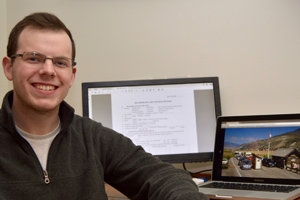Social Sciences
Public Health Research with National Implications

Being a public health student at American University provides the opportunity for unique experiences beyond the classroom, due to the university’s location in the nation’s capital.
While riding the Washington, DC, Metro one day, I met an individual in the United States Public Health Service Commissioned Corps. After recognizing his uniform and striking up a conversation, I learned that he was the head of the Office of Public Health for the National Park Service. A few months later, I found myself as an epidemiology intern under the guidance of David Wong, the chief epidemiologist for the National Park Service. This experience has led to amazing opportunities for me, but could not have been possible without the advice and guidance of the director of the Public Health Scholars Program, Melissa Hawkins, who became closely involved in the project as I furthered my research through an independent study. American University and Washington, DC, put me in a position to become strongly involved in the most recent epidemiological work.
The Centers for Disease Control and Prevention (CDC), under the guidance of the Council of State and Territorial Epidemiologists (CSTE), a leading organization for epidemiologists, maintains an active list of nationally notifiable diseases. The list includes diseases with which most people are familiar, such as Lyme disease or West Nile virus, and diseases that are incredibly feared by the public, such as the Ebola virus or anthrax. When a patient is suspected to have a disease on the list, the healthcare provider is mandated to report it. The data from these cases are then used for a multitude of purposes including surveillance, identification of risk factors, and the allocation of public health resources.
Different health jurisdictions use different methods of data collection, ranging from the traditional pen and paper to a sophisticated computer program. Regardless of the method of data collection, across all platforms there are similar questions, yet differences exist as well, and these differences often make case-reporting challenging at a national level. Recognizing this, the CDC has begun a process of data harmonization (efforts to combine data from multiple sources and formats into a more integrated system) to address some of these discrepancies.
While nearly every jurisdiction asks about potential exposures, the level and detail of these questions could vary greatly. Sources of exposure for cases can often be linked to their travel history, as made evident with outbreaks such as measles at Disneyland, or hantavirus at Yosemite National Park.
The travel history of patients coming down with these diseases would be critical to identifying them as cases involved in the cluster. Additionally, travel history is critical to identifying any individuals who may have been exposed.
In 2013 CSTE established the travel his- tory work group to address these very issues. The goal of this work group would be to take a closer look at the current methods of data collection, pilot a new form with a more detailed approach, and analyze the results to begin to understand how often travel history occurs in case patients.
The workgroup had established goals and created a pilot, with a heavy emphasis on travel history and specific exposure related questions. Jurisdictions could elect to participate in up to eight diseases including anaplasmosis, babesiosis, ehrlichiosis, Lyme disease, tularemia, West Nile virus, cryptosporidiosis, and giardiasis.
When I came on board with the project, they were about halfway through. They had connected with more than 20 health jurisdictions throughout the country and implemented the pilot form. The case reports had been returned, and it was time for data analysis and interpretation. Many of these case reports were handwritten and faxed, so the first step was to input the information.
More than 620 case reports were received, and after an extensive data cleaning process, 609 cases were included.
Overall findings indicated that there is a significant amount of travel history among cases, and that not all of the existing forms ask, or are able to collect this type of information, and the level of detail varies across jurisdictions.
The importance of this project may seem minimal at first glance, but when we address it from the outside it is incredibly important. This study begins to address the travel history of case patients as well as the data collection methods being utilized. It is the first study to do so. The question is, what does this mean for the population? This study is hoping to inspire more dedicated research into this field, which would ultimately inform an improved system to collect information and identify clusters of cases that have not been previously discovered. This can lead to early and rapid detection of problematic areas, and with this information the public health community can quickly respond to prevent future cases, thus improving the health and safety of our global community.
This research would not have been possible if I had been in any other city, or without the support of the great faculty in the Department of Health Studies.

